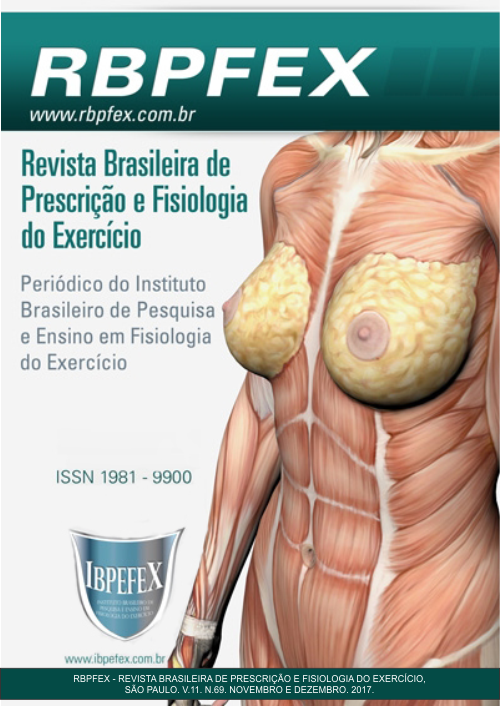Performance analysis of front crawl through kinematics
Abstract
Objective: The objective of this study was to analyze the crawl performance using the kinetics after training intervention. Methods: The sample consisted of 36 swimmers of both sexes between nine and 19 years of age. The study consisted of two stages, with four months between the two, in which anthropometric evaluations were carried out. Body mass (BM), height (H), sitting height (SH), span (S), hand length (HL), neck perimeter (NP) and skin folds (SD) to obtain percentage of fat (%F), and 50-meter and 100-meter swimming-pool crawl in a 25-meter pool, in which the variables total time (TT), partial time (TP), stroke frequency (SF) and stroke length (SL) every 25 meters. Statistical analysis of the data was performed using the t-test in the comparison of the changes during the period of the research, all the stipulated analyzes with a significance level of 0.05. Results: There was an increase in the anthropometric variable BM, H, SH, S and NP, and a decrease in SD and %F during intervention. In the post-test, TT decreased, CB increased and FB decreased in the 50 and 100-meter tests. Conclusion: Better combinations of SL and SF can improve crawl-like sports performance in swimming children and adolescents.
References
-Caputo, F.; Lucas, R.D.; Greco, C.C.; Denadai, B.S. Características da braçada em diferentes distâncias no estilo crawl e correlações com a performance. Revista Brasileira de Ciência e Movimento. Vol. 8. Núm. 3. p. 7-13. 2000.
-Castro, F.A.S.; Guimarães, A.C.S.; Moré, F.C.; Lammerhirt, H.M.; Marques, A.C. “Cinemática Do Nado ‘Crawl’ Sob Diferentes Intensidades e condições de Respiração de Nadadores e Triatletas.” Revista Brasileira de Educação Física e Esportes. Vol. 19. Núm. 3. p. 223-232. 2005.
-Chollet, D.; Chalies, S.; Chatard, J.C. A new index of coordination for the crawl: description andusefulness. International Journal of Sports Medicine. Vol. 21. Núm. 1. p. 54-59. 2000.
-Craig Junior, A.B.; Skehan, P.L.; Pawelczyk, J.A.; Boomer, W.L. Velocity, stroke rate and distance per stroke during elite swimming competition. Medicine and Science in Sports and Exercise. Vol. 17.Núm. 6. p. 625-634. 1985.
-Deminice, R.; Papoti, M.; Zagatto, A.M.; Prado Júnior, M.V. Validade do teste de 30 minutos (T-30) na determinação da capacidade aeróbia, parâmetros de braçada e performance aeróbia de nadadores treinados. Revista Brasileira de Medicina do Esporte. Vol. 13. Núm. 3. p. 195-199. 2007.
-Fernandes, J.R.P.; Lobo da Costa, P.H. Pedagogia da natação: um mergulho para além dos quatro estilos. Revista Brasileira de Educação Física e Esporte. Vol. 20. Núm. 1. p. 5-14. 2006.
-Gallahue, D.L.; Ozmun, J.C. Compreendendo o desenvolvimento motor: bebês, crianças, adolescente e adultos. São Paulo: Phorte. 2001.
-Gomes, A.C. Treinamento Desportivo: estruturação e periodização. Artmed. 2002.
-Guo, X.; Li,Y.; Sun, G.; Yang, Y.; Zheng, L.; Zhang, X.;Sun, Z.; Ma, H.; Wang, N.; Jiang, M.; Li, J.; Sun, Y. Prehypertension in children and adolescents: association with body weight and neck circumference. Internal Medicine. Vol. 51. Núm. 1. p. 23-27. 2012.
-Machado, D.C. Iniciação ao Treinamento. São Paulo. E.P.U. 2006.
-Malina, R.; Bouchard, C. Atividade física do jovem atleta: do crescimento à maturação. São Paulo. Roca. 2002.
-Perez, A.J.; Bassini, C.F.; Pereira, B.M.F.; Sarro, K. J. Correlação entre variáveis antropométricas e o comprimento e a frequência da braçada de nadadores do Espírito Santo. Revista Mackenzie de Educação Física e Esporte. Vol. 10. Núm. 1. p. 19-27. 2011.
-Persyn, U.; Daly, D.; Van Tilborgh, L.; Dessein, M.; Verhetsel, D.; Vervaecke, N. Evaluation of elite swimmers (vídeo). Institut voor Lichamelijke Opleiding. Audiovisuel Dienst, K. U. Leuven, Leuven. 1984.
-Petroski, E.L. Antropometria: técnicas e padronizações. Fontoura. 2011.
-Salo, D.; Riewald, S.A. Condicionamento físico para natação. Manole. 2011.
-Slaughter, M.H.; Lohman, T.G.; Boileau, R.A.; Horswill, C.A.; Stillman, R.J.; Van Loan, M.D.; Bemben, D.A. Skinfold equations for estimation of body fatness in children and youths. Human Biology. Vol. 60. Núm. 5. p. 709-723. 1988.
-Souza, W.C. Los modelos de periodización propuestos por Matveev, Verkhoshanski y Antonio Carlos Gomes. Revista Digital. Buenos Aires. Vol. 17. Núm. 1. 2013.
Authors who publish in this journal agree to the following terms:
- Authors retain the copyright and grant the journal the right of first publication, with work simultaneously licensed under the Creative Commons Attribution License BY-NC which allows the sharing of the work with acknowledgment of the authorship of the work and initial publication in this journal.
- Authors are authorized to enter into additional contracts separately for non-exclusive distribution of the version of the work published in this journal (eg, publishing in institutional repository or book chapter), with acknowledgment of authorship and initial publication in this journal.
- Authors are allowed and encouraged to post and distribute their work online (eg, in institutional repositories or on their personal page) at any point before or during the editorial process, as this can bring about productive change as well as increase impact and impact. citation of published work (See The Effect of Free Access).






